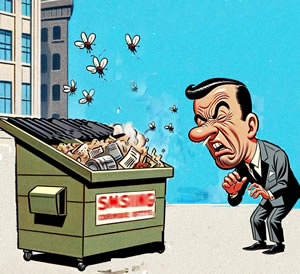When I started working as a freelance writer many years ago, businesses and professionals never heard of content marketing. The term wasn’t coined until 1996. But today, the terms content and content marketing have become buzz words. And instead of surfing the Web, businesses are chumming it with a wide range of content to attract and land customers.
Content — Then and Now
Before the mid-nineties, if a writer or publisher talked about content, they were probably referring to a publication’s Table of Contents.

A small business owner back then might have thought about the contents in their warehouse or refrigerator. Or, they might have wrinkled up their nose if they walked too close to a dumpster out back and got a whiff of its contents.
But while no one used the phrase content marketing back then, businesses and organizations were doing it.
Building Name Recognition and Trust
In the late 1970’s, for instance, I wrote a series of 1-minute product safety scripts for a non-profit organization that wanted to promote itself in Westchester County, NY. The scripts were recorded and aired free as public service announcements on a popular radio station. Each announcement included the name of the organization as the sponsor.
Similarly, it’s long been a common practice for attorneys and other professionals who don’t “advertise” to get name recognition and bragging rights by getting articles published in trade journals or by doing seminars or workshops related to their specialty.
In fact, businesses of all types have been creating and distributing information to market themselves for well over 100 years. They just weren’t doing it to the extent marketers do today. And they didn’t call information, images, and other materials “content.”
What Sparked Today’s Content Explosion
Before online services and the Web came along, the cost of creating, illustrating, printing, and distributing information was a limiting factor for low-budget businesses and groups.
But technological advances started to make it easy to distribute content and promote oneself online. And small, low-budget businesses jumped on the opportunity early on.
The early online services such as GEnie, CompuServe and AOL had file libraries where service users could upload and download articles or shareware (try-before-you-buy) software.
The small businesses and mom-and-pop shops who were using online services at the time quickly recognized that adding their own content (software or articles) to the file libraries was an inexpensive way to market themselves and build a personal brand. (Shareware authors included a file with contact and purchase information as part of their upload; article contributors included author bios and contact information.)

The development of the Web, website-builder software, social media platforms, made it possible to publish content and reach people outside the walls of the subscription-bases online services. Smart phones with cameras that can take good still photos and videos added even more fuel to the fire.
The result? Businesses and individuals are now blasting content out onto the web at an incredible rate. Each day they’re creating a mind-boggling 328.77 million terabytes of data. That equals about 24,657,750,000 printed pages.
Who’s spewing out all that content?
Some of it comes from businesses, non-profits, professionals, and solopreneurs. But a lot comes from private individuals, too. In fact, your teenager or your “elderly” parent or grandparent may be content creators and marketers. (As an FYI, I have grandchildren who are old enough to vote. But I digress….)
How the Content Explosion Affects Your Business
Today’s Internet is yesterday’s proverbial back fence. It’s where people go to learn things, get information about products and services, hear what others think about them, before making a buying decision. (It’s also a place to make purchases, of course.)
Your business needs to produce content to help customers answer their questions and to encourage them to make a purchase from you. Be sure to post text, graphics and video to your own website and to any social media channels your customers and prospects visit. If your customers can’t get information from you, they’re likely to buy from your competitors, instead of you.
For tips on what kind of content you should be creating, check out my Content Creation and Marketing Guide post.
Image sources
Top image and smartphone: Istockphoto
Dumpster: ChatGPT
